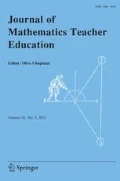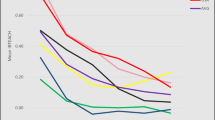Abstract
Teacher education programs have a critical role in supporting prospective teachers’ connections between theory and practice. In this study, we examined three prospective secondary mathematics teachers’ discourses regarding collective argumentation during and after a unit of instruction addressing collective argumentation and ways they recontextualized their on-campus coursework (theory) into their student teaching (practice) as demonstrated by their support for students’ mathematical arguments during student teaching. Through a recursive process of coding data from interviews, reflections, and classroom discussions, we constructed descriptions of participants’ discourses about argumentation based in their coursework and identified three themes about collective argumentation in the prospective teachers’ discourses: the purposes of argumentation, the role of the teacher in argumentation, and characteristics of effective mathematical arguments. Analysis using extended Toulmin diagrams of classroom data from participants’ student teaching showed that these three interrelated themes were visible in the participants’ enactment of moves supporting collective argumentation. Our study opens spaces for future investigations into how teachers recontextualize their learning from coursework (theory) into their practice.








Similar content being viewed by others
Change history
20 June 2021
A Correction to this paper has been published: https://doi.org/10.1007/s10857-021-09502-7
Notes
Mathematical argumentation is defined as interactions that include mathematical claims and warrants or evidence of support for claims (Conner et al. 2014b).
From a Foucauldian perspective, “discourses map out for teachers, students, and others ways of living in the classroom and ways of being within other institutions of mathematics education” (Stinson and Walshaw 2017, p. 140). Ways of communicating and being are seen as shared and understood across communities. These ways of being-in-the-world are accepted as normal or being seen as belonging (Goffman 1959). Mathematical discourse is more than just the spoken aspects of communicating mathematical thinking. Our use of discourses does not only refer to the spoken word and actions (e.g., gestures, facial expressions, representations, power-knowledge relations; Foucault 1972) individuals use to relate to their mathematical thinking or warrant a mathematical claim, but also the representations of social status constructed through language and dialogue (Bhaktin 1981).
The individual defined and argued why the arguments they wrote about in their reflections were more or less effective based on the readings and discussions from the unit on collective argumentation.
Instructional units were designed by the participants and their partners during their student teaching experience. The participants were given liberty to design the unit following the school district’s pacing guide. Cathy’s curriculum materials adopted by the district while Susan designed her own materials based on her mentor teacher’s materials and William co-designed the unit with other student teachers, loosely based on the state curriculum frameworks.
In the larger study following the cohort of prospective students over their 2-year teacher preparation program, interviews 1, 2, and 3 occurred during the first year of the program. During this time, the participants’ coursework peripherally discussed aspects of argumentation but did not go in-depth into mathematical argumentation until the argumentation unit during their 3rd methods course.
Reports generated by Transana include coded transcript excerpts linked to video and are generated by individual codes or combination of codes linked by Boolean operators.
Memo included patterns derived from our analysis of support for argumentation based on extended Toulmin diagrams.
References
Adler, J., & Reed, Y. (Eds.). (2002). Challenges of teacher development: an investigation of take-up in South Africa. Van Schaik Publishers.
Andriessen, J. (2006). Arguing to learn. In K. Sawyer (Ed.), The Cambridge handbook of the learning sciences (pp. 443–459). Cambridge University Press.
Artzt, A. F. (1999). A structure to enable preservice teachers of mathematics to reflect on their teaching. Journal of Mathematics Teacher Education, 2(2), 143–166.
Australian Curriculum, Assessment and Reporting Authority. (n.d.). The Australian Curriculum: Mathematics Proficiencies. Retrieved from https://www.australiancurriculum.edu.au/resources/mathematics-proficiencies/
Bakhtin, M. M. (1981). The Dialogic Imagination: Four Essays (M. Holquist, Trans.). Austin: University of Texas Press.
Ball, D. L., Sleep, L., Boerst, T. A., & Bass, H. (2009). Combining the development of practice and the practice of development in teacher education. The Elementary School Journal, 109(5), 458–474.
Bernstein, B. (2003). Class, Codes, and Control: The Structuring of Pedagogic Discourse (Vol. 4). London ; New York: Routledge. (First published in 1990).
Carpenter, T. P., Fennema, E., Franke, M. L., Levi, L., & Empson, S. B. (2015). Children’s mathematics: Cognitively guided instruction. Portsmouth, NH: Heinemann.
Choppin, J. M. (2007). Teacher-orchestrated classroom arguments. Mathematics Teacher, 10(4), 306–310.
Cohen, E. G. & Lotan, R. A. (2014). Designing groupwork: Strategies for the heterogeneous classroom. New York, NY: Teachers College Press.
Conner, A., Singletary, L. M., Smith, R. C., Wagner, P. A., Francisco, R. T. (2014a). Identifying kinds of reasoning in collective argumentation. Mathematical Thinking and Learning, 16(3), 181–200. https://doi.org/10.1080/10986065.2014.921131.
Conner, A., Singletary, L. M., Smith, R. C., Wagner, P. A., & Francisco, R. T. (2014b). Teacher support for collective argumentation: A framework for examining how teachers support students’ engagement in mathematical activities. Educational Studies in Mathematics, 86(3), 401–429.
Conner, A. (2008). Expanded Toulmin diagrams: A tool for investigating complex activity in classrooms. In O. Figueras, J. L. Cortina, S. Alatorre, T. Rojano, & A. Sepulveda (Eds.), Proceedings of the joint meeting of the international group for the psychology of mathematics education 32 and the North American chapter of the international group for the psychology of mathematics education XXX (Vol 2, pp. 361-368). Morelia, Mexico: Cinvestav-UMSNH.
Conner, A., Edenfield, K., Gleason, B., & Ersoz, F. (2011). Impact of a content and methods course sequence on prospective secondary mathematics teachers’ beliefs. Journal of Mathematics Teacher Education, 14(6), 483–504. https://doi.org/10.1007/s10857-011-9186-8.
Darling-Hammond, L., & Hammerness, K. (2002). Toward a pedagogy of cases in teacher education. Teaching Education, 13(2), 125–135.
Department for Education. (2014). National curriculum in England: Mathematics programmes of study. Author.
Ensor, P. (2001). From preservice mathematics teacher education to beginning teaching: A study in recontextualizing. Journal for Research in Mathematics Education, 32, 296–320.
Featherstone, H., Crespo, S., Jilk, L. M., Oslund, J. A., Park, A. N., & Wood, M. B. (2011). Smarter together! Collaboration and equity in the elementary math classroom. Reston, VA: National Council of Teachers of Mathematics.
Foucault, M. (1972). The archaeology of knowledge (1st (American). . Pantheon Books.
Gee, J. P. (2011). An introduction to discourse analysis: Theory and method (3rd ed.). . Routledge.
Glaser, B. G., & Strauss, A. L. (1967). The discovery of grounded theory: Strategies for qualitative research. Aldine.
Goffman, E. (1959). The presentation of self in everyday life. Doubleday.
Herbel-Eisenmann, B., Drake, C., & Cirillo, M. (2009). “Muddying the clear waters”: Teachers’ take-up of the linguistic idea of revoicing. Teaching and Teacher Education, 25(2), 268–277.
Jansen, A. (2006). Seventh graders’ motivations for participating in two discussion-oriented mathematics classrooms. The Elementary School Journal, 106(5), 409–428.
Jansen, A. (2008). An investigation of relationships between seventh-grade students’ beliefs and their participation during mathematics discussions in two classrooms. Mathematical Thinking and Learning, 10(1), 68–100.
Knipping, C. (2008). A method for revealing structures of argumentations in classroom proving processes. ZDM: The International Journal on Mathematics Education, 40(3), 427–441.
Krummheuer, G. (1995). The ethnography of argumentation. In P. Cobb & H. Bauersfeld (Eds.), The emergence of mathematical meaning: Interaction in classroom cultures (pp. 229–269). Erlbaum.
Krummheuer, G. (2007). Argumentation and participation in the primary mathematics classroom: Two episodes and related theoretical abductions. Journal of Mathematical Behavior, 26(1), 60–82.
Lave, J., & Wenger, E. (1991). Situated learning: Legitimate peripheral participation. Cambridge university press.
Mewborn, D. S. (1999). Reflective thinking among preservice elementary mathematics teachers. Journal for Research in Mathematics Education, 30(3), 316–341.
National Council of Teachers of Mathematics (2000). Principles and standards for school mathematics. Reston, VA: Author.
National Council of Teachers of Mathematics (2014). Principles to Actions: Ensuring Mathematical Success for All. Reston, VA: Author.
Nussbaum, E. M. (2008). Collaborative discourse, argumentation, and learning: Preface and literature review. Contemporary Educational Psychology, 33, 345–359.
Peressini, D., Borko, H., Romagnano, L., Knuth, E., & Willis, C. (2004). A conceptual framework for learning to teach secondary mathematics: A situative perspective. Educational Studies in Mathematics, 56(1), 67–96.
Monty Python. (2008, November 14). Argument clinic [Video file]. Retrieved from https://www.youtube.com/watch?v=DkQhK8O9Jik
Reed, Y., Davis, H., & Nyabanyaba, T. (2002). Investigating teachers’ ‘take-up’ of reflective practice from an In-service professional development teacher education programme in South Africa. Educational Action Research, 10(2), 253–274.
Rodgers, C. R. (2002). Seeing student learning: Teacher change and the role of reflection. Harvard Educational Review, 72(2), 230–253.
Schön, D. A. (1987). Educating the reflective practitioner: toward a new design for teaching and learning in the professions. Jossey-Bass.
Singletary, L. & Conner, A. (2015). Connecting research to teaching: Focusing on mathematical arguments. Mathematics Teacher, 109(2), 143–147.
Smith, M. S., & Stein, M. K. (2011). 5 practices for orchestrating productive mathematics discussions. Reston, VA: National Council of Teachers of Mathematics.
Staples, M., & Newton, J. (2016). Teachers’ contextualization of argumentation in the mathematics classroom. Theory into Practice, 55, 294–301.
Stein, M. K. (2001). Mathematical argumentation: Putting umph into classroom discussions. Mathematics Teaching in the Middle School, 7(2), 110–112.
Stein, M. K., Remillard, J. T., & Smith, M. S. (2007). How curriculum influences student learning. In F. K. Lester (Ed.), Second handbook of research on mathematics teaching and learning (pp. 319–369). Charlotte, NC: Information Age Pub.
Stinson, D. W., & Walshaw, M. (2017). Exploring different theoretical frontiers for different (and uncertain) possibilities in mathematics education research. In J. Cai (Ed.), Compendium for research in mathematics education (pp. 128–155). Reston, VA: National Council of Teachers of Mathematics.
Toulmin, S.E. (2003). The uses of argument (updated ed.). New York: Cambridge University Press. (First published in 1958).
Wagner, P. A., Smith, R. C., Conner, A., Singletary, L. M., & Francisco, R. T. (2014). Using Toulmin’s model to develop prospective secondary mathematics teachers’ conceptions of collective argumentation. Mathematics Teacher Educator, 3(1), 8–26. https://doi.org/10.5951/mathteaceduc.3.1.0008.
Whitenack, J., & Yackel, E. (2002). Making mathematical arguments in the primary grades: The importance of explaining and justifying ideas. Teaching Children Mathematics, 8(9), 524–528.
Woods, D., & Fassnacht, C. (2008). Transana v2.30 [computer software]. Available from: http://www.transana.org. Madison, WI: The Board of Regents of the University of Wisconsin System.
Yackel, E. (2002). What we can learn from analyzing the teacher’s role in collective argumentation. The Journal of Mathematical Behavior, 21(4), 423–440.
Yackel, E., & Cobb, P. (1996). Sociomathematical norms, argumentation, and autonomy in mathematics. Journal for Research in Mathematics Education, 27, 458–477.
Zeichner, K. M., & Tabachnick, B. R. (1981). Are the effects of university teacher education “washed out” by school experience? Journal of Teacher Education, 32(3), 7–11.
Acknowledgements
This paper is based on work supported by the National Science Foundation under Grant No. 1149436. Opinions, findings, and conclusions in this paper are those of the authors and do not necessarily reflect the views of the funding agency. The authors wish to thank Kathleen Heid for comments and suggestions on an earlier version of this manuscript.
Author information
Authors and Affiliations
Corresponding author
Additional information
Publisher's Note
Springer Nature remains neutral with regard to jurisdictional claims in published maps and institutional affiliations.
Rights and permissions
About this article
Cite this article
Gomez Marchant, C.N., Park, H., Zhuang, Y. et al. Theory to practice: Prospective mathematics teachers’ recontextualizing discourses surrounding collective argumentation. J Math Teacher Educ 24, 671–699 (2021). https://doi.org/10.1007/s10857-021-09500-9
Accepted:
Published:
Issue Date:
DOI: https://doi.org/10.1007/s10857-021-09500-9




